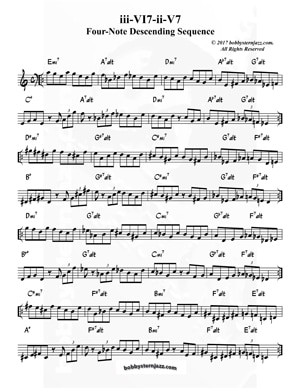Unintended Intro - iii-VI-ii-V Descending Four-Note Sequence

It's basically a four bar sequence which repeats with rhythmic, melodic and directional variations the second time around.
The idea here is to maintain the integrity of the four note cell per measure / chord, while connecting the following measure / chord via a descending (mostly) whole or half step.
This results in the overall descending shape of the line.
The first chord in the graphic below (E-7) should have actually been labeled E-7b5, due to the Bb in the chord voicing.
Playing by the numbers, the line breaks down as such:
Measure #1: E-7 or E-7b5 4-b3-1-4 b3-1-b7-b3 4-note cell (A-G-E-D)
Measure #2: A7alt b13-b9-3-b13 b5-3-b9-b5 (Bb-Db-Eb-F)
Between the the melodic line and the chord voicing, all seven notes of the Bb Melodic Minor scale
(A altered) are accounted for.
Measure #3: D-7 1-b7-5-1 b7-5-4-b7 4-note cell (D-C-A-G)
Measure #4: Ab7alt #9-b13-b7-b9 (E-F#-A-B)
G7alt #9-b9-b13-b7 (Bb-Ab-F-Eb)
When the melody and voicings are combined, both of these chords contain the full compliment of pitches from A and Ab Melodic Minor, respectively.
The Ab7alt (bVI7), is essentially a tritone sub for a D7 (II7), or secondary dominant. The chromatic root movement, from bVI to V7 (commonly found in the 9th & 10th bars of a "Mr. PC" type minor blues), is a bit more interesting.
Resolving momentarily to the tonic chord, the melodic figure changes shape and direction from its counterpart in measure #1.
Measure #6: A7alt Essentially the same as measure #2, with the first 2 beats modified rhythmically with an eighth note rest and triplet.
Measure #7: D-7 An eighth note rest on beat 3 and the second C being omitted from the group is the only difference from meas. #3.
Measure #8: Ab7alt & G7alt The eighth note triplet on beat 3, with the final two notes trading position, are the only differences from measure #4.
Modifying the line slightly in the second 4 bars with rests an triplets gives the line some added rhythmic tension, compared to the steady stream of eighth notes in the first four.
Although I didn't intend it as such, these eight bars came out sounding like a pretty straight ahead, bebop iii-VI-ii-V-I intro that you might hear a rhythm section play to kick off a tune, especially since it resolves momentarily to the tonic chord in bar #5.
Anyway, it be what it B, so check it out and see what you can C.


 RSS Feed
RSS Feed









